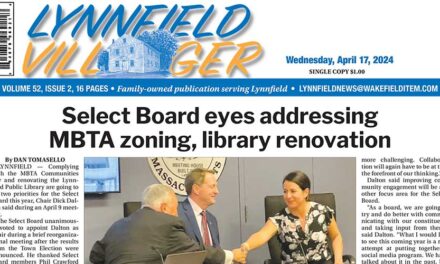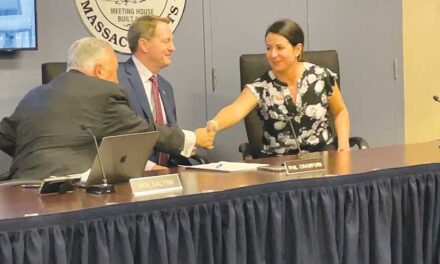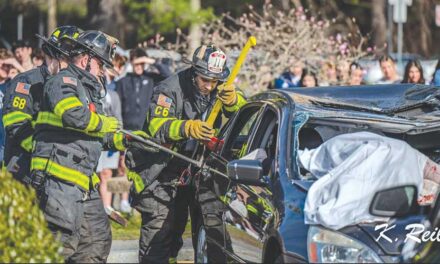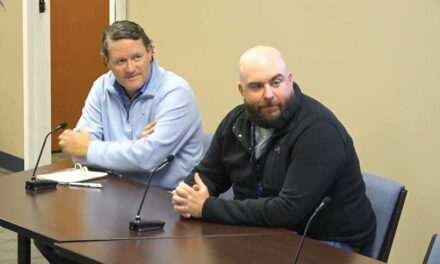By MAUREEN DOHERTY
LYNNFIELD — Investment in the town’s roadway infrastructure was a main topic of discussion at the Finance Committee’s annual public hearing on the town’s operating and capital expense budgets last Wednesday. Voters will be asked to approve these budgets at the annual Town Meeting April 27.
Voters will be presented an operating budget totaling $50.2M and a capital expense budget of at least $1,276,000 for the town as a whole.
If all works out as planned, the town could have upward of $850,000 available in FY’16 between local and state funding sources to put toward roadway maintenance and infrastructure improvements.
The town’s DPW has a plan calling for a 40-year cycle of roadway replacements if between $400,000 to $600,000 is spent annually (in today’s dollars). Since the town has not always been able to dedicate that amount each year this plan, repairs have fallen behind schedule.
The general consensus among town officials and the public during numerous discussions throughout the FY’16 budget creation process is adequate investment in the town’s roadway infrastructure has been inconsistent for many years, in favor of what had been deemed to be more pressing needs of the prior years. So far, FY’16 looks to be shaping up as the year the road.
Finance Committee Chairman Jack Dahlstedt said investment in town’s roads was a central part of the committee’s budget priority discussions with new DPW Director Andrew Lafferty as well as new Town Administrator Jim Boudreau.
Factoring greatly into the amount of money the town can budget for road repairs in any given year is local aid provided by the state. Lynnfield is not alone in having had to scale back its desired roadway maintenance plans when the purse strings at the state level get tighter.
The political climate toward the end of Gov. Patrick’s tenure and the start of Gov. Baker’s tenure in January has favored releasing more funds to cities and towns so they can fix their roads and infrastructure.
The FinCom’s review of Lafferty’s budget, was not limited to roads, however. Dahlstedt said both perennial and new concerns were raised. A “constant concern” of the FinCom is the snow and ice removal budget and the “overages that we’ve had and how we will cover that at the end of the year,” he said. Currently, the town is at least $400,000 over the $120,000 budgeted annually for snow and ice removal during a record-setting season.
Lafferty has conducted a comprehensive “review of the equipment associated with the service that they provide (and has) a real good handle around what the maintenance and the replacement of that equipment should be,” Dahlstedt said.
Maintaining capital facilities town-wide is another priority of the DPW budgeting process, Dahlstedt said, to ensure “that we are doing all the right things to maintain the buildings that we do have so that they do not fall into disrepair.”
Roadwork
“Last and certainly not least on everybody’s minds is the roads,” Dahlstedt said and the FinCom supports the additional investment the town is making in them. “By our calculations, without the additional Chapter 90 money that was potentially put on table last week, we have $850,000 that could be dedicated to our roads,” Dahlstedt said.
Town Administrator Jim Boudreau said, “There is $250,000 (requested) in the DPW line item for road construction for this year. Last year, Gov. Patrick released (through Ch. 90) another $200M, which gives us just over $400,000. And Gov. Baker, when he came in, released $100M, which leaves us with another $200,000-plus, and this was released in January.”
Boudreau added that Baker filed his road transportation bond bill for this fiscal year (2015) of $200M, which could translate into another $400,000-plus for the town “depending upon how much really gets released. I am not sure how much of the original $200M from last year has been expended yet.”
Boudreau was confident that “definitely over $500,000 is available and then we got an additional $62,000 last week in pot hole repair money” out of the share of $30M released state-wide.
Given the availability of all these funding sources, Dahlstedt said his board’s question to Lafferty was: “How much more could you do if you had the resources?”
The answer, Dahlstedt said, was that being able to spend “near the $1M mark was certainly challenge from the perspective of getting contractors in to do the work and getting the pre-work done with his (staff internally). I think in general it is going to be a constant battle to catch up because of the lack of spending that we have done in the past,” Dahlstedt said
Public comments
During the public comments, Katy Shea, a candidate for selectman, stated: “Last year (retired DPW Director) Dennis Roy had calculations on how long it would take to do all the roads, based on funding. Can you give us any indication with these additional funds how long it would take him?”
Dahlstedt said, “As it stands, it is a 40-year plan. And if we spend what our planned budget is, which is usually between $400,000 to $600,000 a year, you accomplish that plan in 40 years. Every year that you don’t spend that, you go backward.”
This road repair plan was updated in the year prior to Roy’s retirement last June “by an engineering student from Northeastern who viewed and rated all the roads (in town),” Dahlstedt said. He said Lafferty will post the list of priority roads to be repaired on the town website soon.
Resident David Miller suggested earmarking the “delta” of new growth money the town has seen, especially due to MarketStreet, toward these DPW priorities like road repairs before they get siphoned off for other priorities “… because our roads are in terrible shape.”
Miller pointed to the $820,000 new growth figure in the preliminary FY’16 budget. “That $820,000 reflects new growth from our homes that we are rebuilding plus MarketStreet. Typically, if you go back in history, we generate $400,000-$500,000 from our own home construction. It seems to me a difference of $300,000, in light of the fact that MarketStreet is 47 percent to be completed and a large portion of that 47 percent is going to be done and count in this new growth next year, that that number, $820,000, will jump to a substantially larger number.”
Dahlstedt said, “Our perspective is, on roads we’d really need to understand how much could you spend if you had unlimited resources. I think that we are approaching that number. I am happy to have the conversation with the DPW Director.”
“We had a philosophical discussion with the DPW Director related to his perspective on the whole road (repair issue) and we were really happy to hear the way he was going to approach roads and the repair of the roads,” Dahlstedt said. This will include repairs to adjacent sidewalks, whenever possible, when road repairs are done.
The FinCom voted on the recommendations the board will make on the floor of Town Meeting for each budget request at its regular meeting Monday night (after press time).




